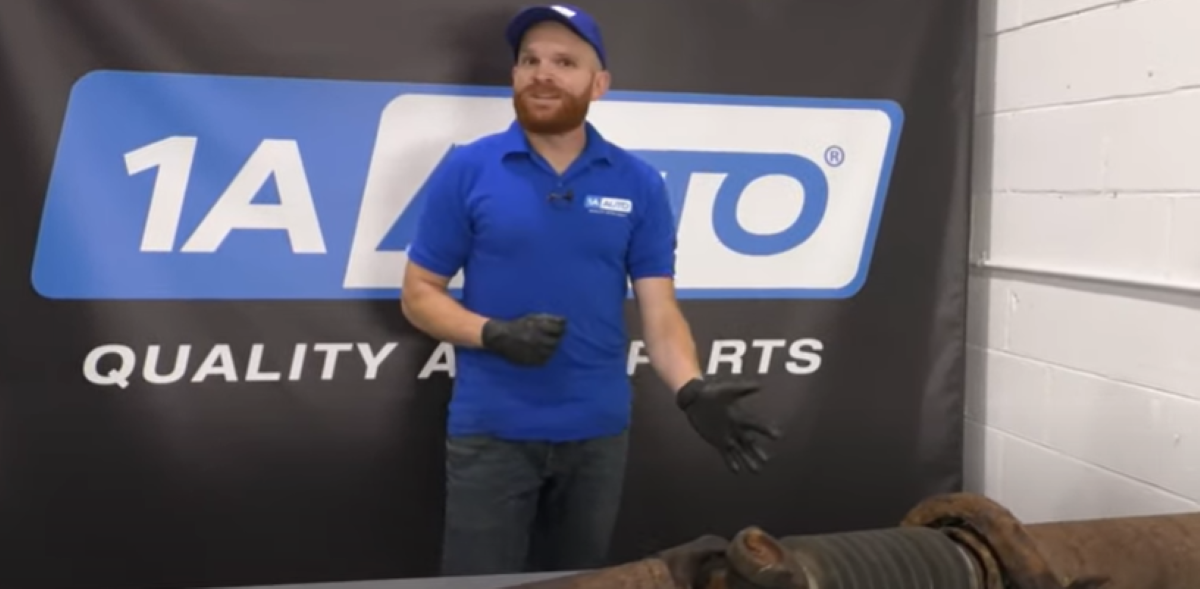Bad carrier bearings, also known as center bearings or center support bearings, can be felt and heard. If you feel a vibration under the vehicle when accelerating or hear the noise of a bad carrier bearing or u-joint like a spinning or grinding, we recommend inspecting the driveshaft and its carrier bearing and u-joints. If the center bearing is loose or worn, we recommend also looking at the rest of the driveshaft, like the u-joints, as there is usually another cause beyond the carrier bearings. This article and video reviews how to inspect both the carrier bearings and the u-joints on the driveshaft.
Video: How to Check Bad Carrier Bearings and U-Joints on the Driveshaft
Symptoms of Bad Carrier Bearings and U-Joints

1. Vibration Under Acceleration
If the carrier bearing loosens, it can separate from the bracket and clunk as the driveshaft spins. Since the driveshaft will spin faster with the accelerating pedal depressed, you might feel a vibration as the engine works harder.
2. Spinning or Grinding Noise Under the Vehicle
If you hear a spinning or grinding noise underneath the cabin of the vehicle, it could be a bad carrier bearing if the internal bearings are worn or if the carrier bearing or u-joints are binding and resisting as they turn.
Free Shipping No Minimum on Quality Auto Parts

Causes of Bad Carrier Bearings and U-Joints
1. Loose Carrier Bearing
The driveshaft sits between the transmission or transfer case and the differential. On many vehicles it has two u-joints. On extended vehicles or those with extended wheelbases, the driveshaft is longer and has at least three u-joints and a carrier bearing. The carrier bearing adds support to the center of the driveshaft, mitigating balance issues and creating less opportunity for flexing or vibrating under acceleration.
If the carrier bearing loosens, this can affect the rotation and balance of the driveshaft, creating vibration.
2. Rusty, Worn, Dry, or Binding Carrier Bearings or U-Joints
If there’s a problem with the carrier bearing, there’s likely another issue with the driveshaft that’s causing it. The internal bearings on the carrier bearings can dry out or wear, and this can be heard as a grinding or spinning noise if the carrier bearings are bad.
U-joints can also bind or freeze up over time from use and corrosion. The bearings on the u-joints can also dry out, causing them to bind or create resistance from a lack of grease. If a u-joint is binding, it can create a shake that can damage the rubber on the carrier bearing and loosen it over time.
The rubber on the carrier bearings can break down and loosen over time from normal wear and tear, but usually from bad u-joints. If the rubber is protruding from the seal in the bracket and is not secured as tightly, it’s time to replace the carrier bearing.
How to Check and Diagnose the Carrier Bearing and U-Joints
Steps to Check and Diagnose the Carrier Bearing and U-Joints
- Remove the Driveshaft
Remove the nuts from the carrier bearing bracket and slowly remove the bracket. Test and inspect the carrier bearing for excessive movement, cracks, or damage. Remove the driveshaft and the inspect the u-joints
- Check for a Bad Carrier Bearing
Try to spin the bearing and listen for a spinning or whirring noise. Wiggle the carrier bearing bracket and check for excessive play—there should be little to no movement. Check the rubber for excessive dry-rotting and cracking. If any of these symptoms appear, check the u-joints for a potential and likely further cause.

- Check for a Bad U-Joint
Move the u-joint up and down and side to side, and spin it around, feeling for tightness or binding. The u-joint should be able to move freely in these directions. Look at all the u-joints for rusting or corrosion that may cause binding. Remove the cap from the u-joint and inspect the inside roller bearings for grease. Dusty and a rusted or red interior means there’s no grease, causing overheating and eventually an issue, meaning the u-joint needs to be replaced.

How to Replace a Carrier Bearing Yourself
If the carrier bearing is worn or defective and needs to be replaced, check out this video below for an idea of the repair process. Find parts and more install videos at 1aauto.com
Shop Parts and Tools
Related Content
- Difference Between 4WD and AWD
- Types of Differentials in Automobiles
- 3 Reasons Your Car Shakes When Accelerating



